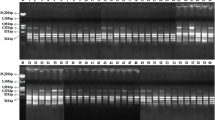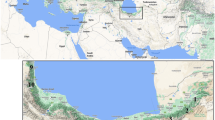Abstract
Hippophae rhamnoides ssp. sinensis is an ecologically and economically important species that has been widely used as a pioneer plant in China. In this study, we employed both nuclear ISSR and maternal cpSSR markers to survey the genetic diversity and structure of populations of ssp. sinensis representing three different landscapes, the northwestern desert and grassland region, the alpine vegetation region of the Qinghai-Tibetan Plateau, and the northeastern humid forest region. In all, 12 natural populations with a scattered distribution in the area were studied. The genetic diversities of populations were found to be uneven, and the total genetic diversity was low on the basis of both types of marker. Mantel tests based on both individual Euclidean distance matrices and population genetic distance (measured by Φpt) matrices showed that the two marker systems detected similar trends with respect to genetic distances between populations. The analysis of molecular variance (AMOVA) revealed significant differentiation among populations and among regions for both types of marker. Although the detected pattern of isolation-by-distance among all sampled populations confirmed the earlier colonization pathway, the low level of gene flow and the lack of isolation by distance within each region suggested the presence of an additional dispersal barrier. UPGMA dendrograms and PCA plots also revealed clear clustering and significant regional differentiation. Our results indicate that the genetic structure of ssp. sinensis has been affected by habitat fragmentation and restricted population sizes. We propose that the biology of reproduction and ecology have played determinant roles in the development of the regional structure of populations. The genetic information obtained will help to establish conservation strategies and programs for sustainable management of H. rhamnoides ssp. sinensis.



Similar content being viewed by others
References
Aitzetmuller K, Xin Y (1999) Sea buckthorn and sea buckthorn oils—recent developments in China and central Asia. Nahrung 43:228–232
Avdeyev VI (1983) Novaya taksonomiya roda oblepikha: Hippophae L. Izv. Akad. Nauk. Tadzh. SSR. Biol. Nauk. 4:11–17
Bartish IV, Jeppsson N, Nybom H (1999) Population genetic structure in the dioecious pioneer plant species Hippophae rhamnoides investigated by random amplified polymorphic DNA (RAPD) markers. Mol Ecol 8:791–802
Bartish IV, Jeppsson N, Bartish GI, Lu R, Nybom H (2000) Inter- and intraspecific genetic variation in Hippophae (Elaeagnaceae) investigated by RAPD markers. Plant Syst Evol 225:85–101
Bartish IV, Jeppsson N, Nybom H, Swenson U (2002) Phylogeny of Hippophae (Elaeagnaceae) inferred from parsimony analysis of chloroplast DNA and morphology. Syst Bot 27:41–54
Bryan GJ, McNicoll J, Ramsay G, Meyer RC, De Jong WS (1999) Polymorphic simple sequence repeat markers in chloroplast genomes of Solanaceous plants. Theor Appl Genet 99:859–867
Chen G, Wang Y, Zhao C, Korpelainen H, Li C (2008) Genetic diversity of Hippophae rhamnoides populations at varying altitudes in the Wolong Natural Reserve of China as revealed by ISSR markers. Silvae Genet 57:29–36
Chen W, Su X, Zhang H, Sun K, Ma RJ, Chen XL (2010) High genetic differentiation of Hippophae rhamnoides ssp. yunnanensis (Elaeagnaceae), a plant endemic to the Qinghai-Tibet Plateau. Biochem Genet 48:565–576
Cheng YJ, Meng HJ, Guo WW, Deng XX (2006) Universal chloroplast primer pairs for simple sequence repeat analysis in diverse genera of fruit crops. J Hortic Sci Biotechnol 81:132–138
Excoffier L, Guillaume L, Schneider S (2007) ARLEQUIN (version 3.11): an integrated software package for population genetics data analysis. Computational and Molecular Population Genetics Lab (CMPG). Zoological Institute, University of Berne, Switzerland
Frankham R (1996) Relationship of genetic variation to population size in wildlife. Conserv Biol 10:1500–1508
Hartl DL, Clark AG (1989) Principles of population genetics. Sinauer, Sunderland
Heuertz M, Vekemans X, Hausman JF, Palada M, Hardy OJ (2003) Estimating seed vs. pollen dispersal from spatial genetic structure in the common ash. Mol Ecol 12:2483–2495
Huff DR, Peakall R, Smouse PE (1993) RAPD variation within and among natural populations of outcrossing buffalo grass Buchloe dactyloides (Nutt) Engelm. Theor Appl Genet 86:927–934
Isagi Y, Tateno R, Matsuki Y, Hirao A, Watanabe S, Shibata M (2007) Genetic and reproductive consequences of forest fragmentation for populations of Magnolia obovata. Ecol Res 22:382–389
Jump AS, Penuelas J (2006) Genetic effects of chronic habitat fragmentation in a wind-pollinated tree. Proc Natl Acad Sci USA 103:8096–8100
Kettle CJ, Hollingsworth PM, Jaffre T, Moran B, Ennos RA (2007) Identifying the early genetic consequences of habitat degradation in a highly threatened tropical conifer, Araucaria nemorosa Laubenfels. Mol Ecol 16:3581–3591
Li C, Xu G, Zang R, Korpelainen H, Berninger F (2007) Sex-related differences in leaf morphological and physiological responses in Hippophae rhamnoides along an altitudinal gradient. Tree Physiol 27:399–406
Lian YS (1988) New discoveries of the genus Hippophae L. (Elaeagnaceae). Acta Phytotax Sin 26:235–237 in Chinese
Lian YS, Chen XL (1992) The ecogeographical distribution of Hippophae rhamnoides subsp. sinensis and its phytogeographical significance. Acta Phytotax Sin 30:349–355 in Chinese
Lian YS, Chen XL (1996) The systematic classification of the genus Hippophae. Hippophae 9:15–24
Lian YS, Chen XL, Wang F (1997) New discoveries of the genus Hippophae L. II. In: Lu S, Li M, Hu J, Liu S (eds) Worldwide research and development of sea buckthorn. China Science and Technology Press, Beijing, pp 60–65
Lian Y, Chen X, Lian H (1998) Systematic classification of the genus Hippophae L. Seabuckthorn Res 1:13–23
Lian YS, Lu SG, Xue SK, Chen XL (2000) Biology and chemistry of the genus Hippophae. Gansu Science and Technology Press, Lanzhou, pp 1–226 (in Chinese)
Liu SW, He TN (1978) The genus Hippophae from Qing-Zang plateau. Acta Phytotax Sin 16:106–108 (in Chinese)
Lu R (1992) Sea buckthorn—a multipurpose plant species for fragile mountains. ICIMOD Occasional Paper No. 20. Kathmandu, Nepal
Lu R (1997) Eco-geographical distribution of sea buckthorn and prospects of International cooperation. In: Lu S, Li M, Hu J, Liu S (eds) Worldwide research and development of sea buckthorn. China Science and Technology Press, Beijing, pp 123–129
Lu XW, Sun K, Ma RJ, Zhang H, Su X, Wang ML (2006) Fruits foraging patterns and seed dispersal effect of frugivorous birds on Hippophae rhamnoides sinensis. Front Biol China 3:318–322
Lu Z, Wang Y, Zhang X, Korpelainen H, Li C (2009) Genetic variation of isolated Picea balfouriana populations from the southeast of the Qinghai-Tibet Plateau. Ann For Sci 66:607 (p1–10)
Mantel N (1967) The detection of disease clustering and a generalized regression approach. Cancer Res 27:209–220
Miller M (2000) TFPGA (version 1.3): tools for population genetic analysis, a windows program for the analysis of allozyme and molecular population genetic data. Department of Biological Sciences, Northern Arizona University
Nei M (1978) Estimation of average heterozygosity and genetic distance from a small number of individuals. Genetics 89:583–590
Nei M (1987) Molecular evolutionary genetics. Columbia University Press, New York
O’Connell LM, Mosseler A, Rajora OP (2006) Impacts of forest fragmentation on the mating system and genetic diversity of white spruce (Picea glauca) at the landscape level. Heredity 97:418–426
Peakall R, Smouse PE (2006) GENALEX 6: Genetic Analysis in Excel. Population genetic software for teaching and research. Australian National University, Canberra
Peakall R, Smouse PE, Huff DR (1995) Evolutionary implications of allozyme and RAPD variation in diploid populations of dioecious buffalograss Buchloe dactyloides. Mol Ecol 4:135–147
Rousi A (1965) Observations on the cytology and variation of European and Asiatic populations of Hippophae rhamnoides. Ann Bot Fennici 2:1–18
Rousi A (1971) The genus Hippophae L. A taxonomic study. Ann Bot Fennici 8:177–227
Ruan CJ, Li DQ (2002) Analysis on the community characteristics of Hippophae rhamnoides L. plantation and water and nutrition of woodland in Loess Hilly Region. J Appl Ecol 13:1061–1064 (in Chinese)
Servettaz C (1909) Monographie des Eleagnacees. Beih Bot Centralbl 25:1–40
Sheng HM, An LZ, Chen T, Xu SJ, Liu GX, Zheng XL, Pu LL, Liu YJ, Lian YS (2006) Analysis of the genetic diversity and relationships among and within species of Hippophae (Elaeagnaceae) based on RAPD markers. Plant Syst Evol 260:25–37
Sun K, Chen X, Ma R, Li C, Wang Q, Ge S (2002) Molecular phylogenetics of Hippophae L. (Elaeagnaceae) based on the internal transcribed spacer (ITS) sequences of nrDNA. Plant Syst Evol 235:121–134
Sun K, Chen W, Ma RJ, Chen XL, Li A, Ge S (2006) Genetic variation in Hippophae rhamnoides ssp. sinensis (Elaeagnaceae) revealed by RAPD markers. Biochem Genet 44:186–197
Swenson U, Bartish IV (2003) Taxonomic synopsis of Hippophae (Elaeagnaceae). Nordic J Bot 22:369–374
Tang X, Tigerstedt PMA (2001) Variation of physical and chemical characters within an elite sea buckthorn (Hippophae rhamnoides L.) breeding population. Sci Horitic 88:203–214
Tian LC, Guan FL, Zhang MY (1993) The preliminary study of flowering features in Hippophae rhamnoides L. ssp. sinensis Rousi and artificial hybridization. Hippophae 6:29–33
Tian C, Lei Y, Shi S, Nan P, Chen J, Zhong Y (2004a) Genetic diversity of sea buckthorn (Hippophae rhamnoides) populations in northeastern and northwestern China as revealed by ISSR markers. New For 27:229–237
Tian C, Nan P, Shi S, Chen J, Zhong Y (2004b) Molecular genetic variation in Chinese populations of three subspecies of Hippophae rhamnoides. Biochem Genet 42:259–267
Wang ZK, Guo BP, Yan LY (1989) Study on features of pollen dispersal of sea buckthorn in mountains. In: Proceedings of International Symposium on Sea Buckthorn, Beijing, pp 186–189
Weising K, Gardner RC (1999) A set of conserved PCR primers for the analysis of simple sequence repeat polymorphisms in chloroplast genomes of dicotyledonous angiosperms. Genome 42:9–19
Wright S (1969) Evolution and genetics of populations, vol 2. The theory of gene frequencies. University of Chicago Press, Chicago
Wright S (1978) Evolution and genetics of populations, vol 4. Variability within and among populations. University of Chicago Press, Chicago
Yang Y, Yao Y, He H (2008) Influence of ambient and enhanced ultraviolet-B radiation on the plant growth and physiological properties in two contrasting populations of Hippophae rhamnoides. J Plant Res 121:377–385
Yao Y, Tigerstedt PMA (1993) Isozyme studies of genetic diversity and evolution in Hippophae. Genet Resour Crop Evol 40:153–164
Yeh FC, Yang RC, Boyle T (1997) POPGENE (version 1.32): software Microsoft Windows-based freeware for population genetic analysis. University of Alberta, Canada
Zhao H, Zhu C, Gao C, Li H, Liu Z, Sun W (1991) Geographical variation of fruit traits of the Chinese sea buckthorn and selection of provenances for fruit use. Hippophae 4:15–18
Acknowledgments
The research was supported by the Program of “Knowledge Innovation Engineering” of the Chinese Academy of Sciences (no. KSCX2-YW-Z-1019) and the Program of “the Light Foundation” of the Chinese Academy of Sciences.
Author information
Authors and Affiliations
Corresponding author
Rights and permissions
About this article
Cite this article
Wang, Y., Jiang, H., Peng, S. et al. Genetic structure in fragmented populations of Hippophae rhamnoides ssp. sinensis in China investigated by ISSR and cpSSR markers. Plant Syst Evol 295, 97–107 (2011). https://doi.org/10.1007/s00606-011-0466-7
Received:
Accepted:
Published:
Issue Date:
DOI: https://doi.org/10.1007/s00606-011-0466-7




